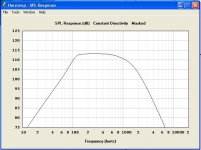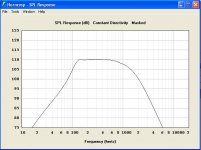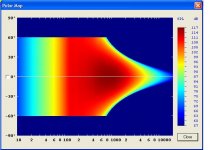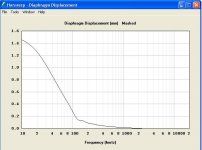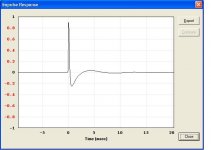Just throwing out some FYI around the numbers I've stated. The 1 L volume is based on real horns I've built. If I recall correctly, the 8PE21 needs around 1 L and the Fane Studio 8M needed something more like 850CC to resonante at 125Hz in a full size 126Hz tractrix. Keele and Leach's math is completely out of wack for this horn. A 4 liter chamber would have tuned it to about 90Hz in that horn - almost does nothing. The foam I use is "Great Stuff" brand and it does setup pretty hard. It removes volume and does not give under acoustic loading. What I like to do is tune about 5Hz to 10Hz higher than my target, and then add a little bit of acoustic stuffing to absorb some of the backwave in the chamber and drop the resonance right to my target frequency.
With the B&C 8PE21 on this horn, Hornresp indicates somewhere around 3.3L to 4L ( depending on whether you use manufacturer or 'measured elsewhere' data for the driver) . This is to get the impedance peak around 125Hz .
I notice the 'no chamber' Hornresp calculation shows the spike at about 60Hz for the stock driver data and 70Hz for the 'measured elsewhere' data , I saw 80 .
I tried making some calcs of the driver volume last night , but I'm struggling to get more than about 1.5 L for everything, which taken off the 5.2L box, should put back-volume in just the right area, really.
Maybe it's about fit/sealing . I may get somewhere with that tonight, if I can find enough Blu-tack - that's the quickest way !
I tried upping the mouth size to a full-size, out of interest, but it doesn't appear to affect the calcs , according to Hornresp .
I notice the 'no chamber' Hornresp calculation shows the spike at about 60Hz for the stock driver data and 70Hz for the 'measured elsewhere' data , I saw 80 .
I tried making some calcs of the driver volume last night , but I'm struggling to get more than about 1.5 L for everything, which taken off the 5.2L box, should put back-volume in just the right area, really.
Maybe it's about fit/sealing . I may get somewhere with that tonight, if I can find enough Blu-tack - that's the quickest way !
I tried upping the mouth size to a full-size, out of interest, but it doesn't appear to affect the calcs , according to Hornresp .
Attachments
Keele and Leach's math is completely out of wack
In a way. Everything except reactance annuling works. If we skip that we get acceptable results like 1,6dm3 for the B&C. Hornresp doesn´t work that way, if I understand it right, so I use my Hypop.
Hmm
However, it's not a constant directivity horn . Analyse it with Tools > Directivity option, axis or 10 or 20 degrees off axis ...
That's why I decided to buy a pair of the remade Fane Studio 8M instead ...
;o)
However, it's not a constant directivity horn . Analyse it with Tools > Directivity option, axis or 10 or 20 degrees off axis ...
That's why I decided to buy a pair of the remade Fane Studio 8M instead ...
;o)
Hmm
However, it's not a constant directivity horn . Analyse it with Tools > Directivity option, axis or 10 or 20 degrees off axis ...
That's why I decided to buy a pair of the remade Fane Studio 8M instead ...
;o)
Here's the polar map. The directivity tool showed constant directivity up to about 400Hz. Then it fell off a cliff.
Attachments
Hmm
However, it's not a constant directivity horn . Analyse it with Tools > Directivity option, axis or 10 or 20 degrees off axis ...
That's why I decided to buy a pair of the remade Fane Studio 8M instead ...
;o)
I don't see the attraction to the Fane driver. The Q values are all wrong for a good horn driver.
GM,
Just curious, could you show us an aperiodic loaded design more practically.
USD Audio AP Mats
Tutorials at SpeakerWorks/USD Audio
These two links are for car audio, but do a decent job of explaining what an AP enclosure does. I built one for my friend's 1977 Cadillac Coupe Deville show car. I built individual enclosures around the magnets - made them as small as possible. Left the very back open so I could attach my home made AP mat. I sandwiched layers of poly quilt batting between two perforated sheets of metal. I kept adding layers until the impedance peak looked "good". It was an incredible space saver and it sounded good.
I don't see the attraction to the Fane driver. The Q values are all wrong for a good horn driver.
If you ever had the pleasure to work with this driver you would understand. Its not always about the numbers, but about the actual real world performance. Its the only woofer ever made that can do +/-3dB from 85Hz to 5KHz at 109dB 1W/M sensitivity.
Edit - And that's without the aid of a phase plug!
I increased the rear chamber to 30 liters and put it against a wall on the floor. Very nice.
The dynamics of that design would be lifeless. Been there done that. Over excursion would also be a problem. Just because it looks pretty on a computer screen doesn't mean it will sound good in the real world.
Is it possible to even get a hold of the Fane 8M anymore, or are my searching skills on the internet to bad?
If you ever had the pleasure to work with this driver you would understand. Its not always about the numbers, but about the actual real world performance. Its the only woofer ever made that can do +/-3dB from 85Hz to 5KHz at 109dB 1W/M sensitivity.
Edit - And that's without the aid of a phase plug!
Yeah, I find that hard to believe. Even if it reached 5kHz, it would be beaming like a laser at that point.
The dynamics of that design would be lifeless. Been there done that. Over excursion would also be a problem. Just because it looks pretty on a computer screen doesn't mean it will sound good in the real world.
You've built a tractrix horn using this driver? Why would it be "lifeless"? What does that mean in technical terms?
Maximum excursion at 60Hz is 0.6mm. Xmax for this driver is +/-1.0mm, and Xvar is +/-4.5mm.
Attachments
GM, and JLH. Having half of your horn skills would make me happy at this point. I'd like to try a catchup.
Would you care to share your favourite text most applicable to this upper bass range of horns?
Would you care to share your favourite text most applicable to this upper bass range of horns?
dirkwright,
Simulate all you want. It doesn't result in real world measurements. Until you can understand that there can be quite large differences between simulations and real life you will not be able to advance your design skills. In the end you have to build a lot of stuff and gain experience. I can tell you from first hand measurements that the impulse response of a 126Hz full size tractrix horn without a back chamber looks more like the Rocky Mountains. This is with either the 8PE21 or the Studio 8M. It lacked taughtness and dynamics/punch. Once reactance was annulled the sound was much more dynamic, better dampened and controlled. The smearing was gone and the silence between notes was much better resolved. It really is a night and day difference.
Simulate all you want. It doesn't result in real world measurements. Until you can understand that there can be quite large differences between simulations and real life you will not be able to advance your design skills. In the end you have to build a lot of stuff and gain experience. I can tell you from first hand measurements that the impulse response of a 126Hz full size tractrix horn without a back chamber looks more like the Rocky Mountains. This is with either the 8PE21 or the Studio 8M. It lacked taughtness and dynamics/punch. Once reactance was annulled the sound was much more dynamic, better dampened and controlled. The smearing was gone and the silence between notes was much better resolved. It really is a night and day difference.
Would you care to share your favourite text most applicable to this upper bass range of horns?
My personal project note book.
 I have over 20 years of projects in that book along with plans, measurements and results. After a while its easy to see the trends and predict the likely results without even picking up a calculator.
I have over 20 years of projects in that book along with plans, measurements and results. After a while its easy to see the trends and predict the likely results without even picking up a calculator.dirkwright,
Simulate all you want. It doesn't result in real world measurements. Until you can understand that there can be quite large differences between simulations and real life you will not be able to advance your design skills. In the end you have to build a lot of stuff and gain experience. I can tell you from first hand measurements that the impulse response of a 126Hz full size tractrix horn without a back chamber looks more like the Rocky Mountains. This is with either the 8PE21 or the Studio 8M. It lacked taughtness and dynamics/punch. Once reactance was annulled the sound was much more dynamic, better dampened and controlled. The smearing was gone and the silence between notes was much better resolved. It really is a night and day difference.
The design I have posted does in fact have a sealed rear chamber.
- Status
- Not open for further replies.
- Home
- Loudspeakers
- Multi-Way
- Best 8" to 12" driver for 130hz tractrix horn
